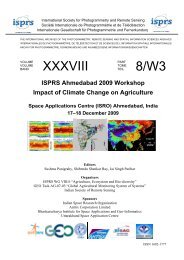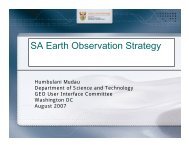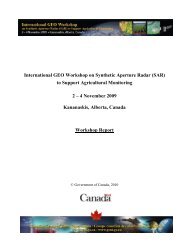GEO UIC Committee: - Group on Earth Observations
GEO UIC Committee: - Group on Earth Observations
GEO UIC Committee: - Group on Earth Observations
You also want an ePaper? Increase the reach of your titles
YUMPU automatically turns print PDFs into web optimized ePapers that Google loves.
The handbook describes eight techniques (e.g., <strong>on</strong>line user surveys, email newsletters,<br />
webinars, c<strong>on</strong>ferences) and serves as a start for developing a <str<strong>on</strong>g>GEO</str<strong>on</strong>g> User Engagement<br />
Handbook. Such a handbook could be a useful tool to build relati<strong>on</strong>ships with and engage users<br />
in the nine <str<strong>on</strong>g>GEO</str<strong>on</strong>g> SBAs. This would help create <strong>on</strong>going users of <str<strong>on</strong>g>GEO</str<strong>on</strong>g>/SS, and provide channels<br />
for user input and feedback. Analysis of <str<strong>on</strong>g>GEO</str<strong>on</strong>g> Tasks indicates that workshops have been the<br />
predominant user engagement mechanism so far. A handbook could help expand the breadth of<br />
techniques used.<br />
Discussi<strong>on</strong><br />
• Jay Pearlman commented that, to be useful, a user engagement handbook must be broader<br />
than <str<strong>on</strong>g>GEO</str<strong>on</strong>g> Tasks, i.e., it should include other programs, but that leads to the questi<strong>on</strong> of how<br />
the relevant programs can be characterized. Lawrence Friedl resp<strong>on</strong>ded that it may make<br />
sense to c<strong>on</strong>duct a program analysis before developing a user engagement handbook.<br />
Operati<strong>on</strong>al Infrastructure of the Global M<strong>on</strong>itoring for Envir<strong>on</strong>ment and Security (GMES)<br />
Marine Core Service: MyOcean—Jun She, Danish Meteorological Institute<br />
Jun She described MyOcean, a single, integrated core service, sp<strong>on</strong>sored by the European<br />
Commissi<strong>on</strong>’s GMES, to apply <strong>Earth</strong> observati<strong>on</strong>s for ocean m<strong>on</strong>itoring and forecasting (see<br />
slides for details). MyOcean provides a single access point (www.myocean.eu) to free and open<br />
data <strong>on</strong> the marine and coastal envir<strong>on</strong>ment, marine resources and operati<strong>on</strong>s, and marinerelevant<br />
climate and weather forecasting. <strong>Earth</strong> observati<strong>on</strong>s are provided by five operating<br />
centres (for sea level, ocean color, sea surface temperature, sea ice and wind, and in situ) and<br />
processed through seven m<strong>on</strong>itoring and forecasting centres (using models for the global,<br />
Arctic, and Atlantic oceans, as well as the Baltic, Mediterranean, and Black Seas) that ensure<br />
data quality; output is provided via a service desk.<br />
MyOcean involves 61 partners in 28 countries. Currently in a 3-year dem<strong>on</strong>strati<strong>on</strong> phase,<br />
MyOcean has a growing number of users; approximately 80 users registered during the first 6<br />
m<strong>on</strong>ths. Users include European policymakers; member states; envir<strong>on</strong>mental, weather, and<br />
ocean agencies; and maritime businesses. <str<strong>on</strong>g>GEO</str<strong>on</strong>g>/SS may benefit from MyOcean forecast and<br />
observati<strong>on</strong>s, and MyOcean may benefit from local validati<strong>on</strong> d<strong>on</strong>e in <str<strong>on</strong>g>GEO</str<strong>on</strong>g>’s ocean-related<br />
Tasks. Development of user uptake protocols to facilitate use of MyOcean data will be an<br />
important future step to improve access and usability.<br />
Opti<strong>on</strong>s and Choices for Meteorological Satellite Direct Broadcast Users in Real-Time<br />
Applicati<strong>on</strong>s—Hung-Lung Allen Huang, Space Science and Engineering Center (SSEC) /<br />
Cooperative Institute for Meteorological Satellite Studies (CIMSS), University of<br />
Wisc<strong>on</strong>sin-Madis<strong>on</strong>, USA<br />
On behalf of Hung-Lung Huang, Ms. H<strong>on</strong>g Zhang described the development and capabilities of<br />
East China Normal University’s (ECNU’s) direct broadcast receiving, processing and applicati<strong>on</strong><br />
system, and how this system c<strong>on</strong>tributes to expanded opti<strong>on</strong>s and choices worldwide for users<br />
of meteorological satellite direct broadcasts. Direct broadcasting systems make satellite data<br />
available to users for meteorological and envir<strong>on</strong>mental modeling and applicati<strong>on</strong>s, including<br />
weather forecasting, natural resources management, drought m<strong>on</strong>itoring, aviati<strong>on</strong> safety, and<br />
climate study. Onsite hardware and software training is provided to users, including scientists,<br />
7







